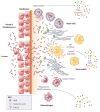Perinatal Group B Streptococcal Infections: Virulence Factors, Immunity, and Prevention Strategies
- PMID: 28633864
- PMCID: PMC5650539
- DOI: 10.1016/j.tim.2017.05.013
Perinatal Group B Streptococcal Infections: Virulence Factors, Immunity, and Prevention Strategies
Abstract
Group B streptococcus (GBS) or Streptococcus agalactiae is a β-hemolytic, Gram-positive bacterium that is a leading cause of neonatal infections. GBS commonly colonizes the lower gastrointestinal and genital tracts and, during pregnancy, neonates are at risk of infection. Although intrapartum antibiotic prophylaxis during labor and delivery has decreased the incidence of early-onset neonatal infection, these measures do not prevent ascending infection that can occur earlier in pregnancy leading to preterm births, stillbirths, or late-onset neonatal infections. Prevention of GBS infection in pregnancy is complex and is likely influenced by multiple factors, including pathogenicity, host factors, vaginal microbiome, false-negative screening, and/or changes in antibiotic resistance. A deeper understanding of the mechanisms of GBS infections during pregnancy will facilitate the development of novel therapeutics and vaccines. Here, we summarize and discuss important advancements in our understanding of GBS vaginal colonization, ascending infection, and preterm birth.
Keywords: Group B streptococcus; ascending infection; perinatal; preterm birth; vaginal colonization infection.
Copyright © 2017 Elsevier Ltd. All rights reserved.
Figures


References
-
- Hillier SL, et al. Microbiologic causes and neonatal outcomes associated with chorioamnion infection. Am J Obstet Gynecol. 1991;165(4 Pt 1):955–61. - PubMed
-
- Norcard N, Mollereau R. Sur une mammite contagieuse des vaches laitieres. Ann Inst Pasteur. 1887;1:109–126.
Publication types
MeSH terms
Substances
Grants and funding
LinkOut - more resources
Full Text Sources
Other Literature Sources
Medical

